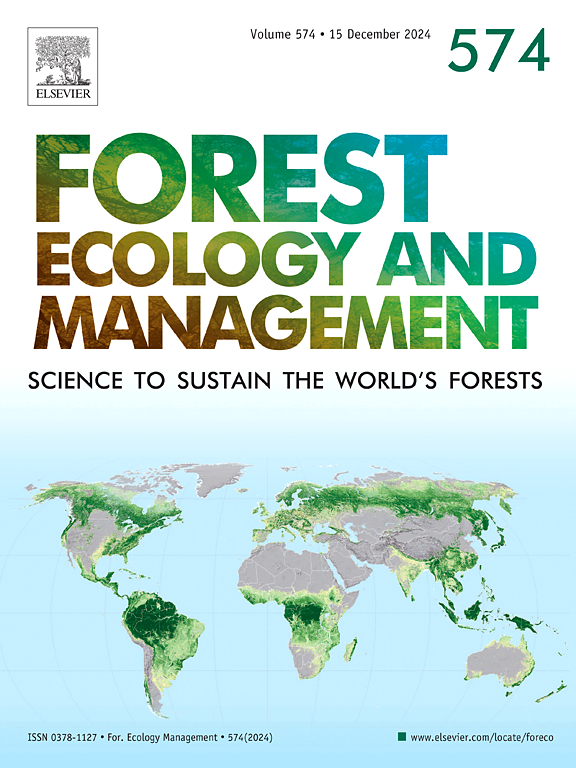Stand age controls canopy and soil rainfall partitioning in slash pine forests
IF 3.7
2区 农林科学
Q1 FORESTRY
引用次数: 0
Abstract
Changing forest structure with stand development is predicted to influence rainfall partitioning, and thus impact forest management and conservation strategies. Extensive pine silviculture in Florida also makes changes in rainfall partitioning with stand attributes consequential for regional water planning. We used weekly measurements of rainfall partitioning and soil water infiltration in two contrasting Pinus elliottii (slash pine) forest ecosystems in north Florida (USA), to quantify stand age and structural development impacts on forest hydrological function. Over 52 weeks - 45 with storms - we observed that stemflow and litterflow were significantly higher, and litter and total interception significantly lower, in the young stand (∼ 10 years since planting) than the mature stand (∼ 21 years since planting) (p <0.05). This was despite negligible differences in leaf area index and other crown structure parameters. We observed substantial differences in trunk storage capacity and trunk saturation point, with greater storage and thus reduced stemflow generation in the mature stand. We show that forest litter stores significant precipitation (7.3 % vs. 10.6 % of annual rainfall for young and mature pine stands, respectively) suggesting total interception predictions that neglect litter storage significantly underestimate actual rates, and overestimate root water availability. We further show that ignoring stemflow in small trees (i.e., young stands) underestimates total stemflow (3.4 % vs. 7.2 % of incident rainfall), leading to an overestimation of canopy and total interception in young stands. We used a reformulated Gash analytical model to obtain weekly estimates of canopy rainfall interception. Our most robust results were observed when we used in-situ partitioning parameters and dynamic canopy cover measurements. However, using literature-derived canopy ecohydrological parameters for southern pines also yielded acceptable predictions given dynamic canopy measurements, suggesting informative generality for application to new settings. Using static canopy measurements yielded consistently inferior results, suggesting that tracking canopy properties is more important for accurate interception predictions than local partitioning parameter estimation. Our results highlight the significance of forest maturity as a factor altering water storage capacity and rainfall partitioning in planted pine stands.
林分年龄控制斜叶松林的树冠和土壤降雨分区
据预测,随着林分发展而改变的森林结构会影响降雨分区,从而影响森林管理和保护战略。佛罗里达州广泛的松树造林也使得降雨分区随林分区属性的变化对区域水资源规划产生影响。我们在美国佛罗里达州北部两个截然不同的埃利奥特松(斜叶松)森林生态系统中,每周测量降雨分区和土壤水分渗透,以量化林分年龄和结构发展对森林水文功能的影响。在 52 周内(其中 45 周有暴风雨),我们观察到,幼林(种植后 10 年以内)的茎流和枯枝流明显高于成熟林(种植后 21 年以内)(p <0.05),而枯枝和总截流明显低于成熟林(p <0.05)。尽管叶面积指数和其他树冠结构参数的差异可以忽略不计。我们观察到树干贮存能力和树干饱和点存在很大差异,成熟林分的贮存量更大,因此产生的茎流也更少。我们发现森林枯落物储存了大量降水(幼龄松林和成熟松林的枯落物分别占年降水量的 7.3% 和 10.6%),这表明忽略枯落物储存的总截流预测大大低估了实际截流率,并高估了根部的水分供应。我们进一步表明,忽略小树(即幼林)的茎流会低估总茎流(占入射降雨量的 3.4% 对 7.2%),导致高估幼林的冠层和总截流。我们使用重新制定的 Gash 分析模型来获得冠层截流的周估计值。当我们使用原位分区参数和动态冠层覆盖测量值时,我们观察到了最可靠的结果。不过,在动态冠层测量的情况下,使用从文献中推导出的南方松冠层生态水文参数也能得出可接受的预测结果,这表明在新环境中应用时具有信息通用性。使用静态冠层测量得出的结果一直较差,这表明跟踪冠层特性对于准确预测截流比估计局部分区参数更重要。我们的研究结果突出表明,森林成熟度是改变人工松林蓄水能力和降雨分区的重要因素。
本文章由计算机程序翻译,如有差异,请以英文原文为准。
求助全文
约1分钟内获得全文
求助全文
来源期刊

Forest Ecology and Management
农林科学-林学
CiteScore
7.50
自引率
10.80%
发文量
665
审稿时长
39 days
期刊介绍:
Forest Ecology and Management publishes scientific articles linking forest ecology with forest management, focusing on the application of biological, ecological and social knowledge to the management and conservation of plantations and natural forests. The scope of the journal includes all forest ecosystems of the world.
A peer-review process ensures the quality and international interest of the manuscripts accepted for publication. The journal encourages communication between scientists in disparate fields who share a common interest in ecology and forest management, bridging the gap between research workers and forest managers.
We encourage submission of papers that will have the strongest interest and value to the Journal''s international readership. Some key features of papers with strong interest include:
1. Clear connections between the ecology and management of forests;
2. Novel ideas or approaches to important challenges in forest ecology and management;
3. Studies that address a population of interest beyond the scale of single research sites, Three key points in the design of forest experiments, Forest Ecology and Management 255 (2008) 2022-2023);
4. Review Articles on timely, important topics. Authors are welcome to contact one of the editors to discuss the suitability of a potential review manuscript.
The Journal encourages proposals for special issues examining important areas of forest ecology and management. Potential guest editors should contact any of the Editors to begin discussions about topics, potential papers, and other details.
 求助内容:
求助内容: 应助结果提醒方式:
应助结果提醒方式:


